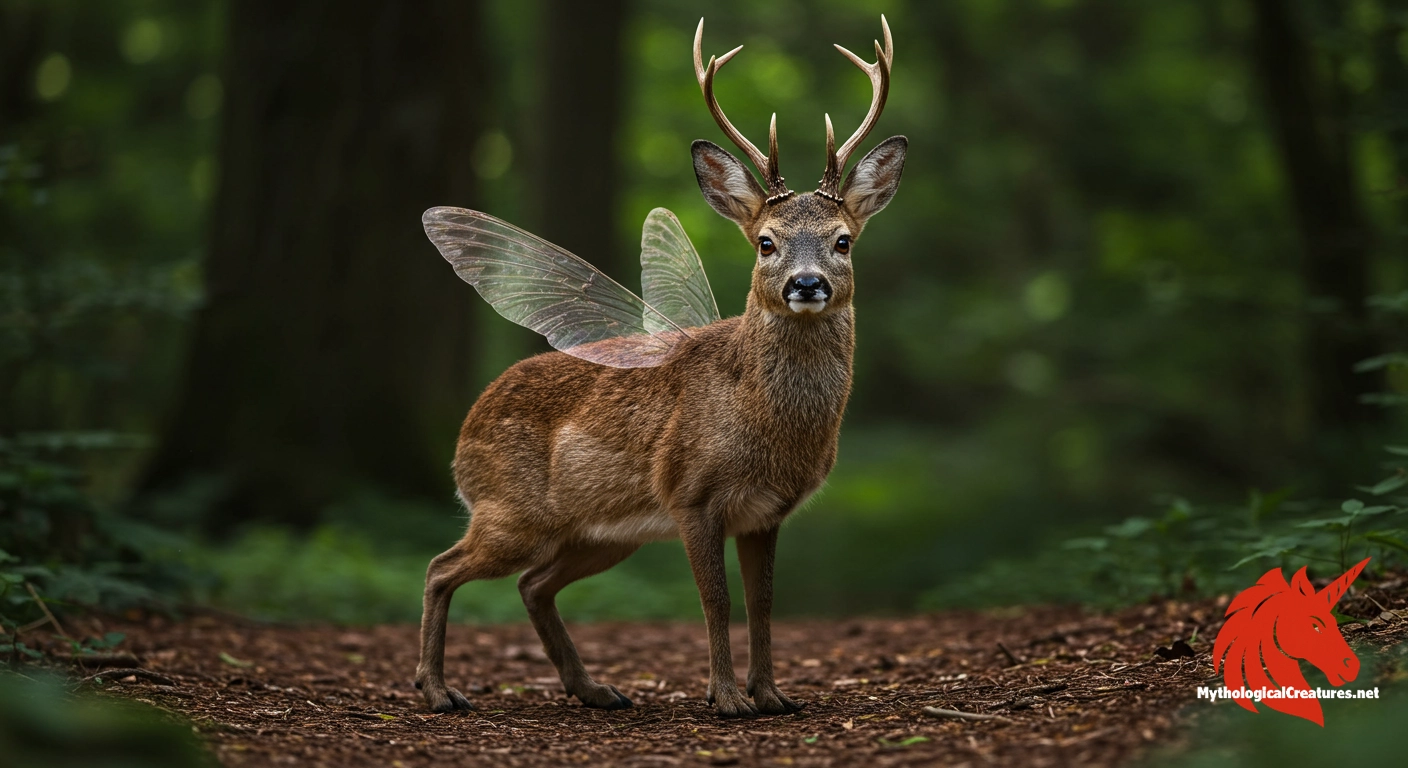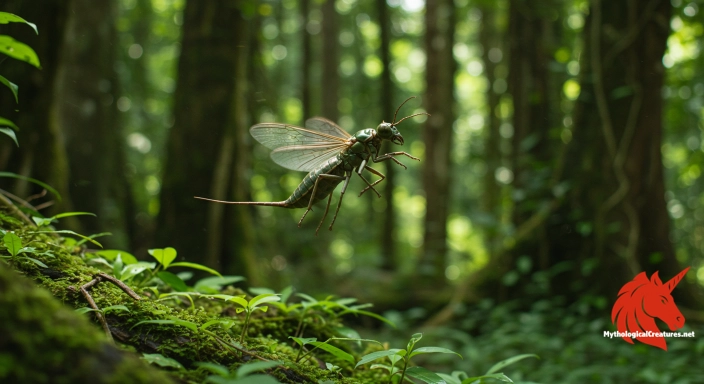Wolpertinger: The Wolpertinger is a whimsical, hybrid creature from German folklore, said to inhabit the alpine forests of Southern Germany.

Wolpertinger
Wolpertinger - Represents the whimsical and imaginative aspects of Bavarian folklore and the creative blending of natural features in myth.
Origins & First Encounters
Deeply embedded in the mystique of the Bavarian Alps, the Wolpertinger stands as a testament to the creative whimsy of German folklore. Its lore is interwoven with the natural splendour of alpine forests, where the creature is said to roam among the rugged landscapes of Bavaria and Baden-Württemberg. Born from the fertile soil of local oral traditions, the Wolpertinger blends various animal features into one captivating mythical being. The creature’s tale is thought to have originated in the hidden corners of rural mountain communities, where imaginative storytellers found inspiration in nature’s unpredictability. Over time, its legend became a playful emblem of regional identity, symbolising both the wonder and the absurdity of the natural world. Early whispers about the Wolpertinger conveyed an air of both magic and mischief, sparking curiosity among locals and visitors alike. Its myth has evolved from mere folktales recounted by the fireside to a celebrated narrative that animates cultural festivals and local art. The enduring charm of the Wolpertinger continues to evoke a sense of enchantment, linking the past with modern imaginative reinterpretations. As a creature born of both the sublime and the comical, it represents the spirit of a landscape that honours nature’s quirks. The story of this composite animal is a living part of the region’s folklore, capturing the hearts of those who seek a glimpse of the fantastical in everyday life.
Source Texts & Tale Variants
The earliest mentions of the Wolpertinger are found more in the realm of oral tradition than in formal historical texts, with anecdotes passed down through generations in remote alpine villages. Local chroniclers and folklore collectors from the 18th and 19th centuries occasionally recorded whimsical accounts of a creature that blurred the lines between reality and myth. Various compilations of Bavarian folk tales include fragmented descriptions, each adding a unique twist to the creature’s nature and appearance. In several regional manuscripts and travellers’ journals, the Wolpertinger emerges as a playful yet mysterious inhabitant of the deep forests. Folklore enthusiasts have noted that the creature’s legend was often recounted during communal gatherings and local festivities, reinforcing its position in the cultural landscape. Diverse sources portray the Wolpertinger with slight differences—some emphasise its gentle, elusive nature while others delight in its exaggerated, fantastical traits. The variety in these accounts has contributed to an evolving narrative that adapts to the cultural context of each retelling. Despite the scarcity of a single, definitive primary source, the multitude of regional records enriches our understanding of its mythic origins. Later folklorists and natural history enthusiasts have also contributed new layers to the tale, blending humour and mystery in their descriptions. The compilation of these varied sources has cemented the Wolpertinger’s role as a cherished and enduring figure in local lore.
Form & Powers
The Wolpertinger is depicted as an astonishing composite of animal parts, which lends it an appearance both bizarre and beguiling. Its form is often described as being that of a small to medium-sized woodland creature, endowed with a blend of features drawn from several species. Commonly, the creature is shown with the antlers of a deer that arch gracefully, contrasting with the soft, rounded features typical of a rabbit. The face may carry an inquisitive expression, highlighted by large, alert eyes that peer from amidst an array of incongruous elements. In many renditions, the creature’s ears are elongated and twitch with a surety reminiscent of a hare, lending it an endearing quality. Some accounts even attribute the creature with delicate, feathered wings or a tufted tail, further enhancing its fantastical silhouette. Its fur is described as mottled or dappled, perfectly camouflaging it within the shadowed undergrowth of the alpine forests. Variations exist from one local tradition to another, with some illustrations showing additional quirky features such as small fangs or extra pairs of limbs. This rich tapestry of physical traits not only challenges our perceptions of natural form but also symbolises the imaginative spirit underlying the myth. In essence, the Wolpertinger’s physical form is a playful experiment of nature, a collage that sparks both wonder and humour.
Regional Faces
Regional portrayals of the Wolpertinger reveal a fascinating spectrum of local imaginative flourishes that reflect the unique characteristics of the alpine environment. In Bavaria, the creature is often depicted with an emphasis on elegant antlers and a somewhat benign presence, mirroring the gentle rhythms of rural life. In contrast, stories from Baden-Württemberg sometimes highlight its spirited and mischievous nature, infusing the legend with a lively, almost impish quality. Local adaptations have resulted in depictions that sometimes include extra appendages or even subtle variations in size, each echoing the distinct wildlife and cultural nuances of its area. In some parts of the region, the Wolpertinger is celebrated in festivals and community gatherings, where its image is rendered with playful exaggeration. This local reinterpretation allows each community to imbue the creature with aspects resonant with their own natural surroundings. The creature’s appearance can shift subtly depending on the slope, forest type, or seasonal setting described by storytellers. It is not uncommon to find that what one region envisions as a serene guardian, another places as a prankster of the woods. Such variations enrich the mythical tapestry of the Wolpertinger, making it both a local icon and a canvas for communal creativity. Ultimately, these regional differences underscore the dynamic and adaptive nature of folklore as it interacts with geographically and culturally diverse audiences.
Cultural Parallels
Examining the Wolpertinger in a broader mythological context reveals intriguing parallels with several hybrid creatures found in other cultures. Much like the American jackalope, which similarly combines the features of a rabbit with those of a horned animal, the Wolpertinger serves as an emblem of the playful intersection between nature and myth. Both beings challenge the limits of biological possibility, merging disparate anatomical elements into a single, fantastical entity. This comparative view highlights a universal human tendency to blend familiar creatures to create symbols that encapsulate mystery and humour. In various traditions, hybrid monsters are employed as a form of satire or as inventive explanations of natural phenomena, reflecting the creative spirit of their communities. The shared thematic elements suggest that the allure of such composite beings crosses cultural and geographical boundaries. In addition, these creatures often act as metaphors for the unpredictable and multifaceted nature of the natural world. Their depictions invite audiences to question the boundaries of the real and the imagined, encouraging a playful re-examination of nature’s wonders. Across cultures, this motif of blending animal traits serves as a recurring narrative device that reinforces the idea that nature is full of surprises and contradictions. Such cross-cultural connections deepen our appreciation for the Wolpertinger’s role as a myth that both entertains and instructs its audience.
Legacy & Modern Evolution
The historical journey of the Wolpertinger mirrors the broader evolution of myth from a rural curiosity to a celebrated modern emblem. Initially confined to the whispered tales of mountain villagers, the creature has gradually transcended its humble beginnings to become a symbol of cultural identity and whimsical heritage. In more recent times, its image has been reimagined in artworks, postcards, and souvenirs, contributing to its enduring presence in popular culture. Contemporary depictions often embrace an irreverent humour, highlighting the creature’s absurd yet endearing qualities. Modern festivals and local exhibitions frequently feature artistic renditions of the Wolpertinger, celebrating it as a playful fusion of history and imagination. The creature now occupies a space where tradition meets modernity, symbolising both a reverence for local folklore and an appreciation for inventive storytelling. As a figure that continues to evolve, it serves as a reminder of the power of communal myth-making and the enduring influence of nature-inspired narratives. Cultural events centred around the Wolpertinger often invite reinterpretations that blend traditional elements with modern artistic sensibilities. Its legacy has also inspired numerous contemporary storytellers and illustrators, ensuring that its myth remains dynamic and accessible to new generations. Thus, the Wolpertinger stands as a vibrant bridge between the rich past of alpine folklore and the creative impulses of the present.
Interesting Fact
A notable observation is that the Wolpertinger, much like the North American jackalope, is a product of collective folklore that blends various animal characteristics into a single, fantastical entity.
Quick Creature Info
Origin:
Features:
Our Mythic Legendary Rating:

Also Sometimes Known As:
Habitat:
Physical Attributes:
Abilities:
Behavior:
Lore:
Related Creatures, Tales or Lore
References
Discover Another Mythical Legend You May Not Have Heard Of?
Uncover the mysteries of ancient folklore and expand your knowledge of legendary beings from cultures around the world.
Dare to Meet the Pelesit....
Mythical Disclaimer: The images and data on this site are derived from various historical and literary sources, but we have found that many myths often have multiple versions and interpretations across references, sometimes contradictory. As a result, these creature depictions are artistic interpretations—imaginative blends of folklore, legend, and a dash of AI guesswork. Because creature descriptions vary widely, our illustrations and accompanying information represent our best effort to honor mythology while bridging creative gaps. Enjoy these interpretations—just remember, we've done our best to respect the stories and validate available data, but in the realm of mythology, details often shift, imagination leads the way, and nothing is ever set in stone!
Curated by the Mythological Creatures Team (rev. May 2025)
